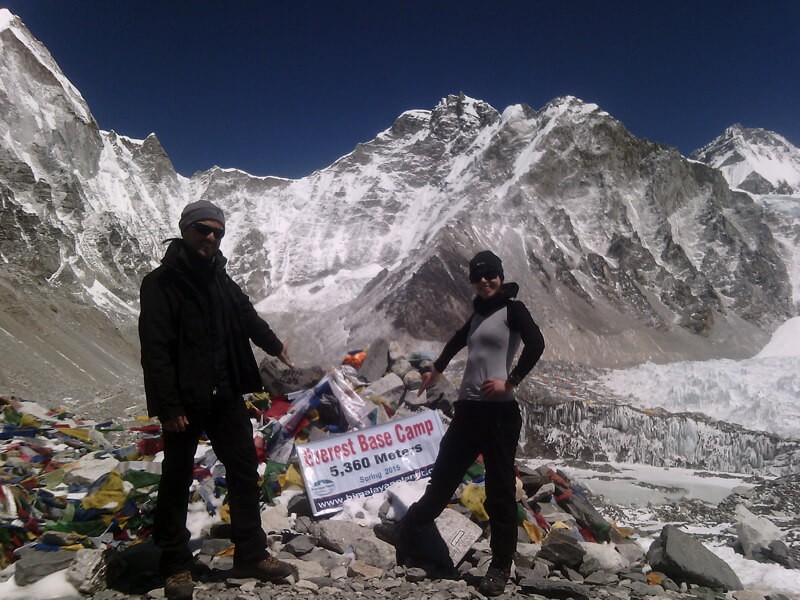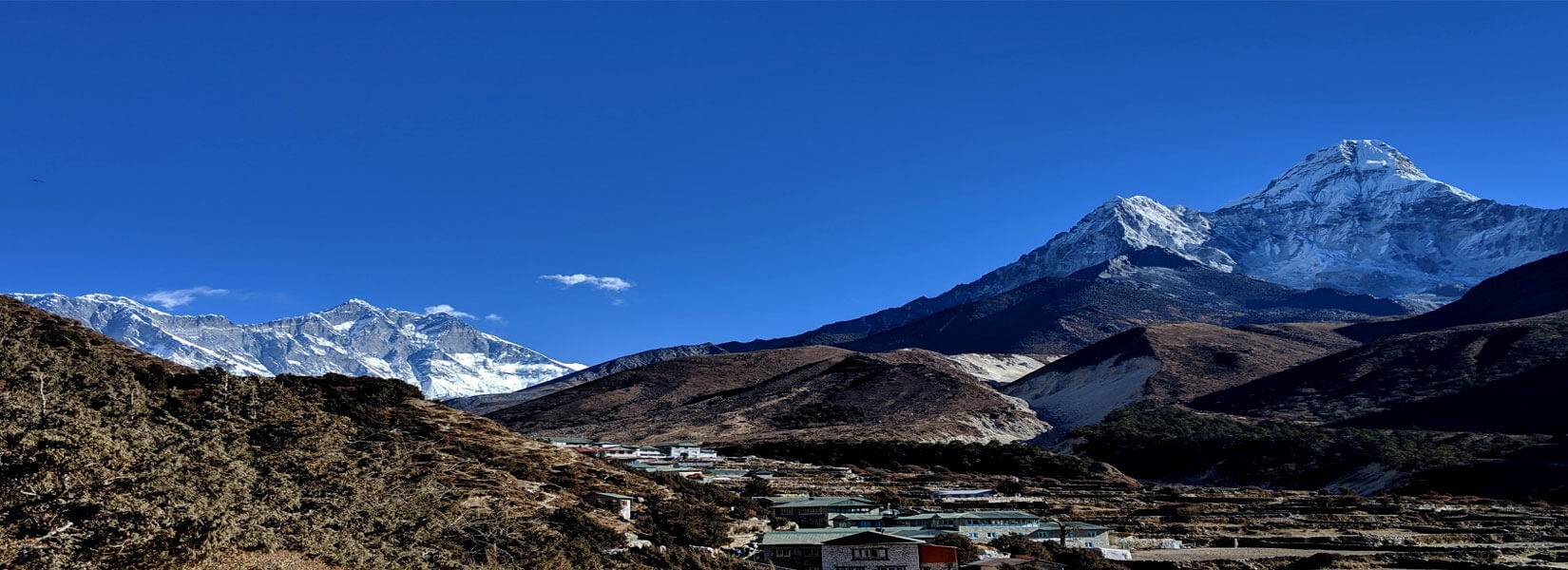Everest Base Camp Trek 14 Days Itinerary
Day 01: Arrival in Kathmandu (Height: 1,350m/4,429ft)
When you arrive in Kathmandu from your home country, you are picked up by the representative of the respective travel agency you have booked. They will take you to the hotel or lodge they have booked as per your demand. If you have enough time that day, you can take a round of the major tourist attractions in the valley. At the end of the day, they will give you brief information about the package, trekking route, and other preparations you have to make for the trip.
Day 02: Flight to Lukla (2,840m/9,318ft) and trek to Phakding (2,610 m/8,563ft)
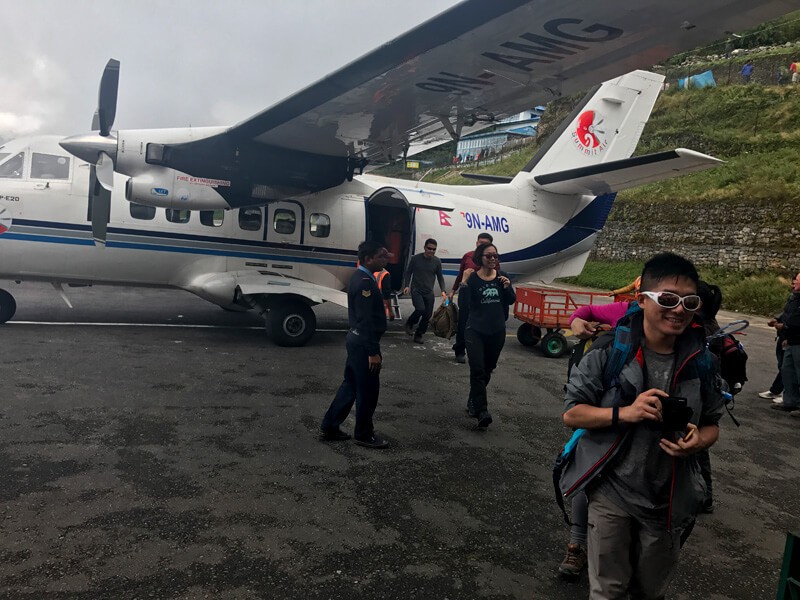
On the second day, you will start your journey to Lukla (Tenzing Hillary Airport) having only one runway, from Tribhuvan International Airport, Kathmandu. Though it is just a 35-minute flight, you can observe the most enthralling scene of the Himalayas ever in your life. After you reach Lukla, you will trek to Phakding by crossing beautiful forests of rhododendrons, magnolia, and pine trees. The major attraction of Phakding is the local monastery which can be visited for peace and tranquility.
Day 03 : Trek to Namche Bazaar (3,440m/11,286ft)
On the third day, you will ascend towards Namche Bazaar, the main market hub in the Khumbu region. On the way, you will walk along the bank of the Dudh Koshi River and the beautiful pine forests naturally arrayed themselves. You have to go across the Hillary Suspension Bridge, named after the pioneer of mountaineering Sir Edmund Hillary. Similarly, you will walk past Sagarmatha National Park, a park located at the highest altitude in the world. The national park is beautified by the presence of endangered species of animals like Himalayan bear, Thur, red panda, etc. Namche Bazaar, being the major marketplace of the region has many luxurious hotels and lodges and banking institutes with ATM booths in here.
Day 4 : Day Trip to Namche Bazaar for Acclimatization
As you have already arrived at an altitude of 3,440 m (11,286 ft), you need to be familiar with this height so that you can climb up higher. For acclimatization to prepare you for further trekking, you will hike up to 300 meters high and descend to Namche Bazaar for the night stay. The major sites to see here are a local monastery and few local schools.
For a 360-degree view of the Himalayas around the Everest Region, Hotel Everest View is the best location for travelers to acclimatize. Everest View Hotel is at an altitude of 3880m (12,729ft) and is said to be the only hotel at the highest altitude in the world. It is just 271 meters higher than Namche Bazaar. You can cross the 1.5 km distance within around an hour of hiking from Namche Bazaar. Being here, you can have the most wonderful view of the Himalayas ever in your life. From here, you can have a rarely close view of Mt. Everest, Mt. Ama Dablam, and Mt. Thamserku in front of you.
Day 5 : Trek to Tengboche (3,860m/12,664ft)
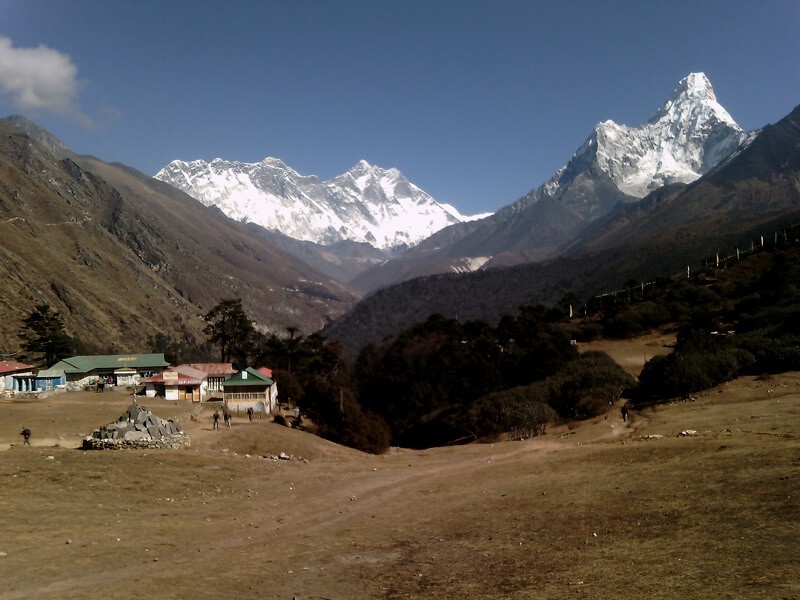
On the fifth day, you will set off for Tengboche by walking across the stone steps. You can have a majestic view of the mountains of Ama Dablam, Thamserku, and Khumbila. The Sherpas of the Khumbu Region regard these three mountains as the Sacred Mountain of the patron god of this vicinity. Tengboche is the largest monastery located in the region, the climbers and trekkers visit this to take blessings from the lamas for successful ascend.
Day 6 : Trek to Dingboche (4,410m/14,468ft)
On the sixth day, you will walk past the lush alpine forests with their appealing beauties. The settlement areas and their houses show you the lifestyle of the people living in the high Himalayas. In the course of walking upside, you will go across Khumbila Khola Valley naturally decorated with blissful landscapes and steep mountains like Mt. Taboche, Mt. Nuptse, Mt. Cholatse, and many more with white scarves on them. Now, you will realize the variation in the vegetation into shrubs and small plants as the altitude and the climate have changed.
Day 7 : Day Trip to Dingboche for Acclimatization
As the climatic region and the altitude change here at Dingoche, you need to adjust your physical and psychological state for further ascending. Therefore, this seventh day is your second acclimatization to fully prepare you for the challenges to come ahead. On this day, you can make a short hiking to Nagarjun Hill just up from Dingboche to adjust with the altitude. Due to the spectacular scenery of the surrounding area, you will forget the steep and rocky trail of this place. More than this, the silvery looks of Mt. Ama Dablam really makes you forget all the tiredness and hurdles you faced in the previous days.
Day 8 : Trek to Lobuche (4,910m/16,108ft)
Today, it is your eighth day and time to trek up to Lobuche. Even though you will have to walk across the moraine rift of the Khumbu Glacier, you will forget this trouble as the mountains around you inspire to complete this hard task, perhaps! When you reach the top of the hill, you will forget the bygone hardships in those days and prepare yourself for other challenges. There are numerous memorials of the climbers who lost their lives in the course of climbing Mt. Everest and other different mountains. The memorials will be boosting you up to accomplish the task. You’ll feel as if they were blessing you for the successful achievement for your dream of trekking!
Day 9 : Trek to Gorak Shep (5,140m/16,863ft) and continue to EBC(5,364m/17,598ft)
The day ninth is the most awaited one in this whole trekking schedule as today you are going to accomplish your dream of being at the Everest Base Camp! Rising early in the morning, you will head towards Gorak Shep which was the original base camp until the 1953 expedition before Everest Base Camp. While climbing towards Gorak Shep, you will have a wonderful view of the Khumbu Glacier despite the rough trails to be followed. At Gorak Shep, you keep your load and walk upwards the EBC slowly to prevent altitude sickness which may obstruct your victory over the mission! Now, you are at the prime location of your trekking Everest Base Camp at an elevation of 5,364 m. The sense of victory and the spellbinding sight of the Khumbu Icefall make you forget the obstacles you face during the journey. After enjoying the natural view from the top, you climb down to Gorak Shep to spend the night over there.
Day 10 : Hike to Kala Patthar (5,550m/ 18,208ft) and trek to Pheriche (4,240m/13,910ft)
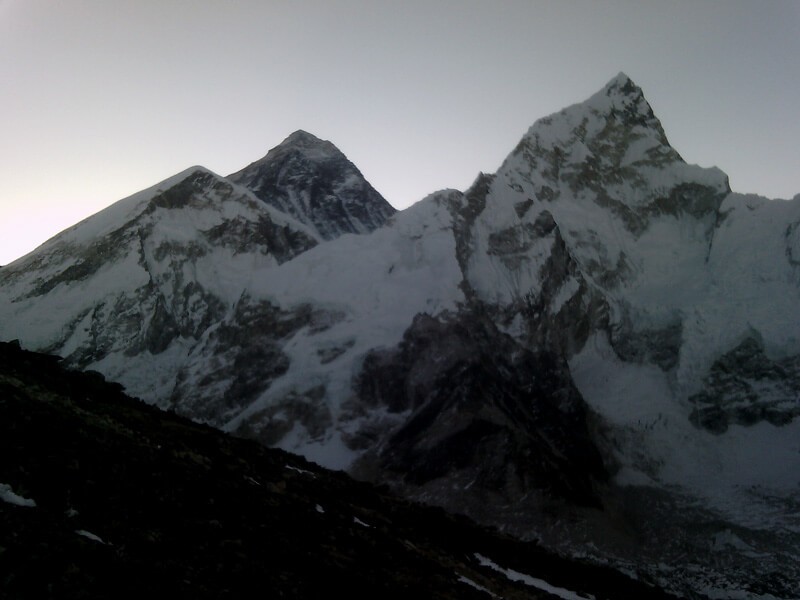
Today, you will hike to Kala Patthar which is the best point to have a full mesmerizing view of Mt. Everest. To have the perfect view of Mt. Everest, Mt. Makalu and other mountains, you have to walk before the sun rises. From here, you can have 360 degree view of Mt. Everest, Mt. Pumori and the surrounding mountains which can’t be really seen from EBC itself because Mt. Lhotse blocks it here. After capturing the hypnotic view of the Everest region in your camera and memory, now you head towards Pheriche where you will spend the night.
Day 11 : Trek to Namche Bazaar
On the eleventh day, it’s time for retreat to Namche Bazaar, the market hub of the region. You will climb down the massive hills to reach Namche Bazaar. You have to cross a number of suspension bridges and come to see the travelers going to attain the success towards the opposite direction. After arriving here, you feel really relieved! And, you can indeed celebrate your success as you can find standard hotels, cafes and lodges with all types of amenities.
Day 12 : Trek to Lukla
Today is the last day of your trekking because you are going downwards Phakding where you can take a short break for rest. Then, you will head down to Lukla to spend the last night of the journey in the lap of the Himalayas. Here you can have hot baths and proper rest to prepare yourself to fly to Kathmandu the following day. You can even cherish the night with parties along with your fellows to mark the accomplishment of the trekking!
Day 13: Fly back to Kathmandu
On the thirteenth day of the journey, you will fly back to Kathmandu from Lukla. During the flight, you can have a fascinating view of the mountains wrapped with in snow, and clusters of houses in the highlands of Nepal. The final sight of the Himalayas and rest of the memories during the trekking will be reminiscent for your whole life. You can hardly buy them even though you are ready to spend billions of dollars or even more! Arriving in Kathmandu, you can spend the day merrymaking for the feat you have achieved this time! Or, you can travel around the valley for more details and wonderful sites enlisted in the UNESCO World Heritage List. You can even go for shopping souvenirs and outfits to your nearest and dearest ones in your home country!
Day 14 : Departure or engage in some other activities as per your demand and desire
You enjoyed your vacation most fascinatingly and funnily perhaps! You are going back to your country with the most invaluable asset i.e. happiness and contentment that remains throughout the life. The representative of the travel agency follows you up to Tribhuvan International Airport for final see off if you have finished your vacation. And in case you wish to extend the stay in Nepal, we will be happy for making you other arrangements for more comfort and satisfaction.
Everest Base Camp Trek Guides and Porters Cost
Because you are new to this trekking route, you may have a lot of hurdles during the journey as you don’t know quite well about it. We suppose trekking in a group is far more interesting and funnier than doing it alone or in a few numbers. To know in more details about the place you walk across may have a good story behind it and knowing it definitely strengthens and enriches your experience during the journey.
And if you hire a well trained, insured and skillful guides, it will in fact add up fun to your journey because they will help in difficult situations and guide you through the most attractive part of the route. Similarly, it is not always possible for you to carry the load of your stuffs you need everyday. Even if you want and are in the best of your health condition, you may not be able to uplift the load as you are unfamiliar with the topography of the region. So, we suggest you to hire the sturdy porters who are not only strong but friendly and responsible to take care of your luggage during the trekking.
The porters and guides will blend your journey with some interesting facts and fictions about the particular site. Apart from this, they will sometimes crack jokes so that you can forget your boredom and tiredness due to the continuous journey up and down the mountainous region. If there come some problems like that of health or altitude sickness, they will honestly help you to recover from such situations. More than that, the professional guides and porters will wisely assist you to escape such threatening situations.
The trekking agency helps you in finding such good human beings who can really contribute to make your journey memorable and pleasant. You have full rights to know better about the guides and the porters to be helping you during the trip. You may know about the type of them and the services to be provided by them with the agency which has organized your Everest Base Camp Trek. The average cost for hiring such expert guides is approximately USD 30 per head per day and for the porters you have to pay about USD 20 per day per head.
Food and Beverage Cost
Trekking across the mountainous region requires a good deal of nutrition for the body to get energy to complete the mission successfully. To remain in the best of your health, you are suggested to have local and hygienic food items. Prefer for vegetarian food rather than meat items because meat is not fresh at this height. The contaminated meat and food can ruin your health. Likewise, the water found in the local area may not be drinkable or even if drinkable, may not be compatible to your health condition. For sure, if the water you have drunk is not hygienic and pure, you may suffer from some waterborne diseases like cholera. To protect yourself from such health hazards, you must have enough hygienic food and pure water.
You can find enough number of teahouses and some good quality hotels throughout the trekking routes. They serve you with local typical food items like Dal Bhaat to continental cuisines as per their standard and availability of facilities. The cost of food and beverage is “the higher up you ascend, the higher price you have to pay”! Breakfast costs from $3 to $10 and the Nepali typical food Daal bhaat and dinner or lunch are served at $5 -$10 per head per meal. However, the average cost for a bottle of mineral water is between $1 and $4. A cup of tea and coffee can be purchased at the price of from $2 to $4 and beer per can is charged between $5 and $10. And you know the plus point of eating in such places is the majestic view of the snowcapped mountains around the Everest Region!
Accommodation Cost
Just as we need quality food and beverage, we also need good and sound sleep for proper rest. Having good sleep is not possible without good hotels or lodges with peaceful environment equipped with clean beddings. Hotels and lodges are found at the stations along the trekking routes.
They remain almost fully occupied in the season whereas may be vacant during offseason. It is really very hard to book a hotel or lodge for accommodation in the seasons because the number of travelers is high in this time of the year. Thus, you had better get the agency to book the hotels and lodges in advance to escape such hurdles. Nonetheless, in offseason, it is very easy to find them and book them on your reach there.
The cost of accommodation differs from one hotel or lodge to the other as their standard and facilities they serve to their guests vary from one to another. But generally, you can book a hotel or lodge at the sum of from USD 5 to USD 40+ per person per night. When you stay at the hotels and lodges there, you can feel the panoramic view of the snow reflecting the sun and the moon in cool temperatures.
Everest Trekking documents Cost
TIMS (Trekkers’ Information Management System) is a permit card that is very helpful for tracking a trekker in case he/she is lost or has health-related problems like frostbite, altitude sickness, and so on. This card is issued by the Nepal Tourism Board, Bhrikuti Mandap, Kathmandu, and is different for an independent trekker and trekkers in an organized group. For an independent trekker, a TIMS card is of green colored one and you have to pay USD 20. But recently it is not mandatory for a trekker who visits the restricted area and peaks climbing. For an organized group of trekkers, this is a blue-colored card that is charged USD 10. The responsibility of issuing this TIMS card goes to the agency which has organized the trip.
Sagarmatha National Park Entry Permit
Another document required while doing Everest Base Camp Trek is the Sagarmatha National Park Entry Permit which costs NRS 3300 for both the independent trekker and the group of trekkers arranged by an agency. The individual trekker and the organized group of trekkers can get this entry permit from the Nepal Tourism Board, Bhrikuti Mandap, Kathmandu, and from the entrance in Monjo as well.
Gaurishankar Conservation Project Area Entry Pass
If you start your trekking from Jiri, Dolakha, you need this permit for Everest Base Camp Trek. The cost for this permit card needs NRS. 3300 for both independent and organized trekking. This card is issued by Nepal Tourism Board, Bhrikuti Mandap, Kathmandu or from Shivalaya, Dolakha.
Flight Ticket Cost for Lukla
Since Lukla (Tenzing Hillary Airport) is the gateway for Everest Base Camp Trek, you can fly there from Tribhuvan International Airport (TIA), Kathmandu. In seasons, Civil Aviation Nepal arranges many flights from Kathmandu to Lukla to Kathmandu. There is always a possibility of poor visibility and other climatic or weather-related challenges in the Lukla Region which results in the cancellation of the flights. The best time for booking the comfortably luxurious flights to Lukla is before 10 AM because in the afternoon the weather of Lukla gets windy and troublesome. The two-way flight cost for foreigners is USD 370, for Indians INR 18,400 and for the Nepalese only NRS 10,400 respectively.
First Aid Kit
While traveling in the high Himalayan Region, you should always be equipped with a First Aid Kit. This prevents you from possible health hazards which otherwise, can compel you to cancel your trip. Basically, the following items should be included:
- Suncream
- Baby wipes
- Toiletries
- Blister Plasters
- Oximeter for altitude
- Hand sanitizer
- Advil
- Aleve
- Vicks Vapour Rub
- Chapstick
- Anti-nuaseant
- Bandaids
- Eye drops
- Advil Cold and Dinus
- Nasal Moisturizer
- Q-tips
- Tweezers
- Tiger Balm
- Paracetamol for headache and fever
- Diamox or altitude sickness medicine
- Immodium for diarrhea due to water and food
- Gear List for Everest Base Camp Trekking
Top Gear
Gear in a simple sentence is the set of equipment required for doing a particular task. Of course, trekking to the high Himalayas is also a very important task that can’t be accomplished without gear. We are going to suggest you the set of gear required to have your trekking done without any flux. As lodging during Everest Base Camp Trek is in teahouses, hotels, and lodges as per availability, tents and kitchen items are not necessary. The following is the detail of gear you need to manage before your trekking starts:
- Backpacks
- Sleeping Bags
- Water Purification
- Water Filter
- Water Purifier (Liquid and Tablets)
- Water Bottle (Hard and Soft)
- Clothing
- Rain Jacket
- Rain Pants
- Down Jacket
- Hiking Pants
- Underwear
- Hiking Shorts
- Hiking T-shirt
- Hiking Long-Sleeve
- Hiking Socks
- Warm Socks
- Shoes
- Trail Runners
- Gaites
- Snow Traction
- Best Accessories
- Headlamps
- Stuff Sacks
- Back Packing Seat
- Portable Camp Chair
- Gear Repair
- Compass
- GPS Phone Apps
- Trekking Poles
- Sunglasses
- Multi tool
- Camp Towel
- Bug Repellant
- Camera
- Power Bank
- Tripod
- Book
Orbit Alpine Adventure (P) Ltd. is an agency established by a very experienced person who has been continuously involved in the trekking field for tens of years. Because he has gained practical experience working right from the ground root to the manager of such activities, he knows very well about the needs of all kinds of the foreign and domestic travelers who want to measure the height and length of the major trekking routes of Nepal. You are encouraged to book your trip through this agency as you can get all types of facilities you require at the best reasonable price. The motto of Orbit Alpine Adventure is “Clients’ happiness!” The owner of the agency is selling different trekking and tour packages to the clients throughout the world. He makes you happy at large by making your trip successful and memorable. He has provisioned the best well trained, insured and skillful guides and porters who are accustomed to different trails of the country. So, for the best satisfaction and successful journey, don’t forget to contact our agency!
